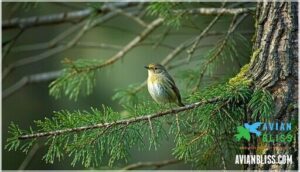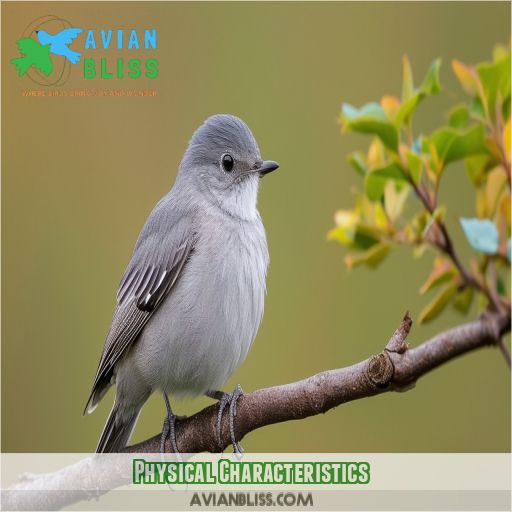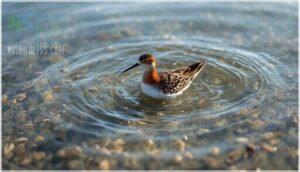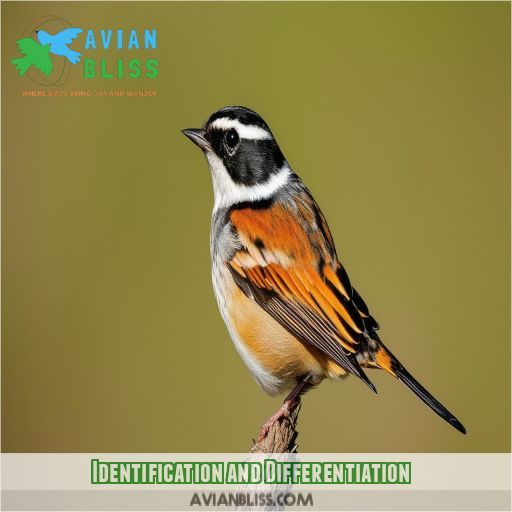This site is supported by our readers. We may earn a commission, at no cost to you, if you purchase through links.
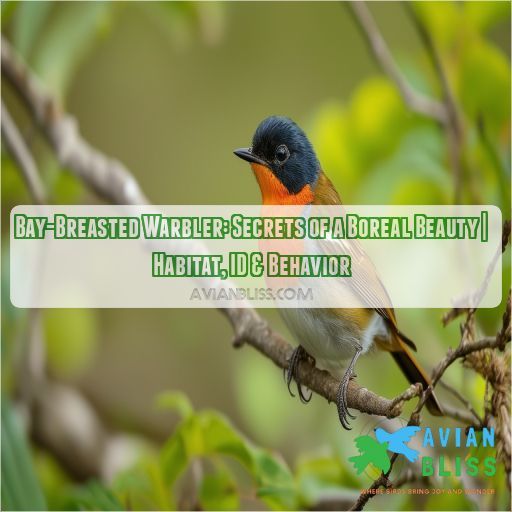
The bay-breasted warbler, resplendent in its vibrant plumage, is an alluring creature of the boreal forests.
This article will guide you through the warbler’s habitat, unique characteristics, and peculiar behavior.
From nesting habits to conservation efforts, you’ll gain insight into the life of this "boreal beauty".
Table Of Contents
- Key Takeaways
- Habitat and Range
- Physical Characteristics
- Behavior and Niche
- Diet and Foraging
- Nesting
- Identification and Differentiation
- Conservation and Climate Vulnerability
- Frequently Asked Questions (FAQs)
- Where does the bay-breasted warbler live?
- What is the niche of the bay-breasted warbler?
- What is the difference between chestnut sided and bay-breasted warbler?
- What is the difference between a blackpoll warbler and a bay-breasted warbler?
- What are the warblers migration patterns?
- What are the differences between male and female warblers?
- How does the warblers diet change with seasons?
- What are the primary threats to the warblers habitat?
- How successful is the warbler at reproducing?
- Conclusion
Key Takeaways
The bay-breasted warbler is a boreal beauty with striking plumage and unique characteristics. Its vibrant colors and distinctive song are sure to captivate.
These birds inhabit boreal forests, favoring spruce-fir ecosystems for breeding and rearing young. Their preference for mature coniferous forests and deliberate foraging habits distinguish them from other warblers.
The warbler’s diet consists largely of spruce budworms, rendering them crucial partners in maintaining forest health. This specialized diet contributes to their "Least Concern" conservation status.
However, climate change and habitat loss present significant challenges to the bay-breasted warbler, underscoring the necessity of conservation initiatives to safeguard the continued existence of this enchanting species.
Habitat and Range
You’ll find the Bay-breasted Warbler thriving in the boreal forests of eastern Canada during summer. These agile birds have a penchant for spruce-fir forests, where they set up shop for breeding season.
Come winter, they’re off to tropical climes, swapping evergreens for forest edges and second growth in Central and South America.
Their range isn’t static, though. Climate change is pushing their breeding grounds northward, while habitat loss in wintering areas poses a threat.
Keep an eye out for these beauties during spring and fall migrations, when they pass through eastern North America.
Physical Characteristics
As you venture deeper into the boreal forest, you’ll find the Bay-breasted Warbler’s physical traits are as alluring as its habitat. This small songbird sports a striking breeding plumage that’ll draw your attention.
Males flaunt a black mask, rich chestnut crown, and rufous red flanks, while females show a more understated version of this pattern. You’ll notice their stout bill, perfect for nabbing insects, and long wings that carry them on their impressive migrations.
Their short tail and bold white wingbars add to their distinctive look, making them a true treasure among warblers.
Behavior and Niche
As you’ve learned about the Bay-breasted Warbler’s distinctive looks, let’s explore its fascinating behavior and ecological niche. You’ll find these boreal beauties exhibiting unique traits that set them apart from other warblers.
Here are four key aspects of their behavior:
- Deliberate foraging style
- Distinctive "teesi-teesi-teesi" song
- Preference for mature coniferous forests
- Migratory patterns influenced by spruce budworm outbreaks
In their breeding grounds, you’ll observe males arriving in early June, ready to establish territories and attract mates. Their courtship displays are subtle yet charming. As neotropical migrants, they face challenges like forest fragmentation and pesticide spraying during their long journeys to wintering habitats in tropical forests.
Diet and Foraging
You’ll find Bay-breasted Warblers to be voracious insect predators, with a particular fondness for spruce budworms. These boreal beauties can devour over 13,000 budworms per hectare in just 41 days!
While they specialize in this diet, they’re not picky eaters. You’ll spot them foraging deliberately among branches, often joining mixed-species flocks. In winter, they’ll switch things up, feasting on berries and other insects.
Their foraging specialization plays a vital role in forest health, keeping budworm populations in check. It’s this dietary niche that helps maintain their "Least Concern" conservation status.
Nesting
You’ll find bay-breasted warblers nesting in dense coniferous forests, typically in spruce or fir trees. These birds build large, open cup-shaped nests 4 to 40 feet above the ground, using a variety of materials including grasses, lichens, roots, and mosses.
Nest Placement
You’ll find Bay-breasted Warblers nesting in coniferous forests, primarily spruce and fir. They’re picky about their nest site selection, choosing spots 4-40 feet above ground. During spruce budworm outbreaks, nest density skyrockets. These clever birds expertly conceal their cup-shaped nests among dense branches, blending them seamlessly with the surrounding foliage. It’s a masterclass in avian architecture!
Nest Description
You’ll find the Bay-breasted Warbler’s nest, a masterpiece of avian architecture, nestled in the dense foliage of spruce and balsam fir forests. This songbird crafts a large, open cup-shaped structure using an intricate blend of grasses, lichens, roots, and mosses. The nest’s interior is lined with soft bark strips and hair, creating a cozy haven for its precious eggs.
Nesting Facts
Bay-breasted warblers usually build their nests around 16 feet high, but they can be anywhere from 4 to 40 feet above the ground. Males arrive on the breeding grounds in early June, and the female incubates the 4-5 eggs for 12-13 days. The nestlings are fed by both parents and leave the nest after 11-12 days.
Identification and Differentiation
Now that you’re fully versed in the nesting habits of the bay-breasted warbler, let’s delve into the intricacies of identification and differentiation. This section will explore the unique characteristics that distinguish this warbler from other species, equipping you to spot them with expertise in the wild.
The bay-breasted warbler has a distinctive song structure, similar to the Cape May and Black-and-white Warblers. Its call is flat and undulating, with a unique "teesi-teesi-teesi-teesi" pattern. One key physical differentiator is the bluish-grey soles of their feet, which distinguish them from Blackpoll Warblers. During the nesting season, these warblers typically forage at medium heights, and during migration, they favor smaller trees and shrubs. Their migration routes span from the northern United States and Canada to tropical wintering habitats, making them a neotropical migrant bird.
Conservation and Climate Vulnerability
Bay-breasted warblers face a variety of challenges that impact their conservation status and vulnerability to climate change. While their conservation status is currently listed as low concern, these birds are vulnerable to population fluctuations due to spruce budworm outbreaks, which can cause local population booms. However, they’re also threatened by the broader impacts of global climate change and habitat loss on their wintering grounds.
The range of these warblers in eastern Canada is particularly susceptible to the effects of climate change, and they face an additional threat from collisions with communication towers. As the environment changes, the future of the bay-breasted warbler is uncertain. Their numbers may continue to fluctuate, and conservation efforts will be essential to ensuring their long-term survival.
Frequently Asked Questions (FAQs)
Where does the bay-breasted warbler live?
Bay-breasted warblers breed in the boreal spruce-fir forests of eastern and central Canada, and the extreme northern United States. They winter in the tropics of South and Central America.
What is the niche of the bay-breasted warbler?
The bay-breasted warbler’s niche involves breeding in boreal spruce and fir forests of eastern and central Canada, along with the northern United States. They feed on spruce budworms, insects, and spiders, which they glean from vegetation.
What is the difference between chestnut sided and bay-breasted warbler?
Chestnut-sided warblers have a bright yellow crown, dark mask, and white cheek and throat in breeding plumage. Bay-breasted warblers have a rusty crown, throat, and dark cheeks.
What is the difference between a blackpoll warbler and a bay-breasted warbler?
What makes a warbler a warbler? When comparing the blackpoll and bay-breasted species, you’ll notice differences in their undertail coverts and breast streaking. A blackpoll warbler will show white feathers in its long undertail coverts, while a bay-breasted warbler’s will be tinted with buff. A blackpoll will also show blurry dull-greenish streaking on its breast, whereas a bay-breasted lacks streaking.
What are the warblers migration patterns?
Warblers are Neotropical migrants, meaning they spend winters in South America, Central America, and the Caribbean, and travel as far north as Canada to breed. They migrate at night, orienting themselves by the position of the sun, magnetic fields, and innate compasses.
What are the differences between male and female warblers?
How well do you know your warblers?
Male warblers are typically more vibrant in color, with bright yellow markings and black streaks on their backs.
Female warblers, in contrast, have duller, brownish plumage with paler yellow patches.
Come breeding season, males are more likely to serenade and perform courtship displays.
Females take on the primary role of nest-building, while males rarely gather nesting materials but often sing as their mates gather supplies.
How does the warblers diet change with seasons?
In winter, warblers tend to feed on insects in the tropics. In spring, they drink from flowers and eat mealworms and sugar water. In summer, they eat insects and berries.
What are the primary threats to the warblers habitat?
Habitat loss in wintering grounds and pesticide spraying for spruce budworms are the primary threats to the Bay-breasted Warbler’s habitat. Canada has taken steps to protect large areas of boreal forest, preserving millions of acres of habitat for the species.
How successful is the warbler at reproducing?
The bay-breasted warbler’s reproductive success is closely tied to the spruce budworm population. When budworms are plentiful, warblers produce more young. However, pesticides used to control budworms have led to a 74% population decline since
Conclusion
The bay-breasted warbler is a colorful songbird, captivating all who encounter it.
This article has taken you on a journey into its vibrant world. From its preferred habitat in the boreal forests to its unique nesting habits, the warbler’s behavior and characteristics have been explored.
With knowledge of its diet, physical traits, and conservation status, we can appreciate this avian species and its place in the ecosystem.
The bay-breasted warbler is an intriguing creature, and by learning its secrets, we gain insight into the wonders of nature.

